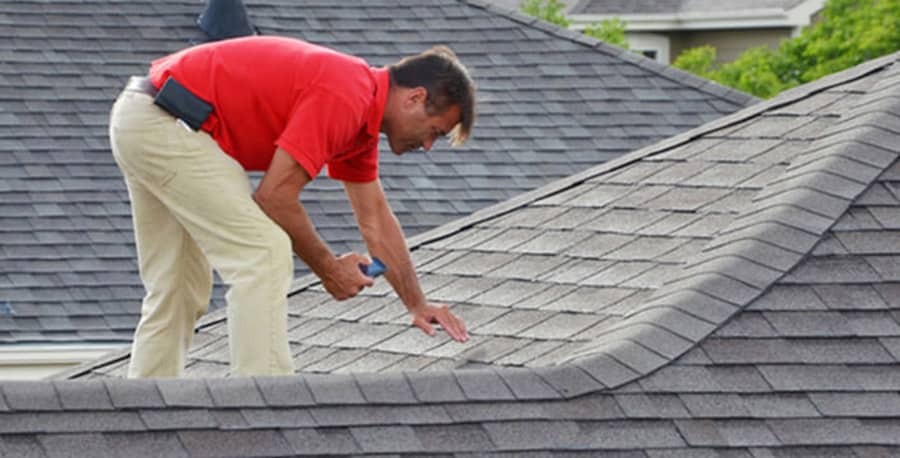
Home inspection roof issues include a failing structure (sagging), poor installation or workmanship, leaks, missing/damaged shingles, improperly installed flashings, and clogged gutters and downspouts.
It’s not easy to determine the condition of a roof purely by its look, especially for the untrained eye. If you’re about to spend a significant sum of money on a new home, a NACHI or ASHI-certified home inspector will be able to help you identify problems the roof could be suffering from, saving you some money in the process.
According to HomeAdvisor.com, the average roof repair cost is between $353 and $1,439, with an average price of $890, but this varies considerably depending on the severity of the issue. A complete roof replacement can cost anywhere from $5,351 – $10,819. That $500 investment for a home inspector doesn’t look too bad suddenly.
Want to read more about red flags in home inspections? We have a list of red flags during a home inspection that can help you confidently select a new home.
This article will look at typical home inspection reporting of roof issues.
The Roof Structure
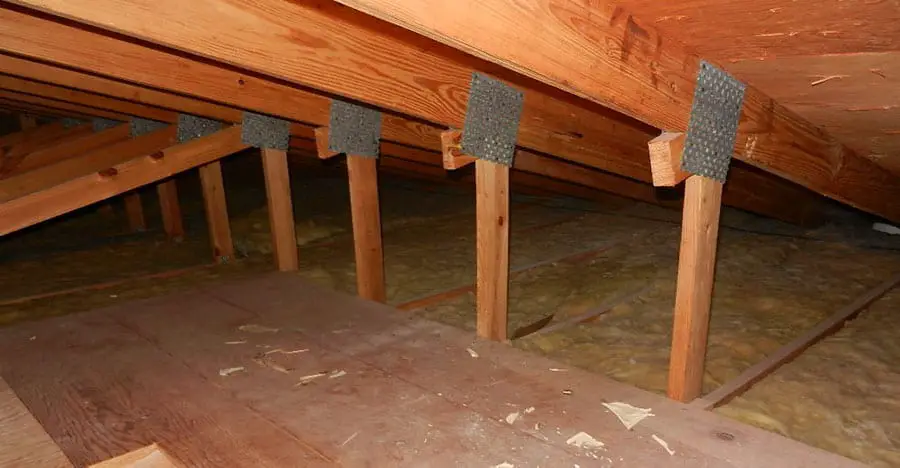
The home inspector will assess the roof’s structural integrity during their visit. They will check for specific structural problems such as roof sagging, roof spreading, rot, and rust at key support points.
Sagging occurs in areas across the roof due to weakened joists that hold the roof in place. Similarly, roof spreading occurs when the downward pressure of the weight of the entire roof becomes too much and starts to move the structure out of place. Typically, these issues are many years in the making. The longer they are left untreated, the more severe the damage.
Problems such as roof sagging and spreading usually arise from exposure to large amounts of rain and snow, especially if the drainage system is inadequate. It can also indicate more serious issues, such as the foundation shifting, sinking, or settling. This would require both a roof and foundation repair.
Home inspectors will assess the roof in a couple of ways. Provided it’s safe and weather permitting, the home inspector will walk the roof to get a sense of the strength of the roof sheathing. Walking on the roof helps the inspector feel how much flex is in the roof sheathing, particularly in crucial areas such as valleys, chimney saddles, and roof penetrations.
The other way is through the attic space. This is an area that often tells the story the best. The attic allows you to see prior or current leak activity. You can also see whether the roof structure is built from traditional joist and rafter construction or roof trusses.
Defects in the roof structure can tell an inspector a lot about the overall strength and health of the house. Inspectors will be looking for damaged or altered trusses, proper bracing on rafters, twisting of rafters, and the condition of the roof sheathing.
The Interior
When we think about roof inspections, we tend to think about the condition of the roof exterior while forgetting about the interior. This is a vital part of the home that can give clues to potential issues affecting the rest of the building.
The interior inspection includes checking the attic for proper insulation to ensure no unnecessary heat loss during the winter months. Inspectors will also assess the level of ventilation in the attic, ensuring there is no buildup of mold or mildew, which are indicative of some form of water penetration.
A lack of ventilation in the roof can lead to increased condensation, which can deteriorate the roof prematurely due to timber rot.
The inspector will look for signs of leaking in the form of water stains, delaminating wood, and damp smells, all of which can cause roof decay and extensive damage.
The home inspector is also looking for water spots on the ceilings that could clue them into potential problem areas to focus on inside the attic.
Unfortunately, not all attic areas are sometimes accessible for inspection. This is common in vaulted roofs and flat roofs. This will often prompt the inspector to direct you to an examination by a licensed roof contractor, which could involve the removal of a portion of the drywall to access the underside of the roof.
Roof Materials
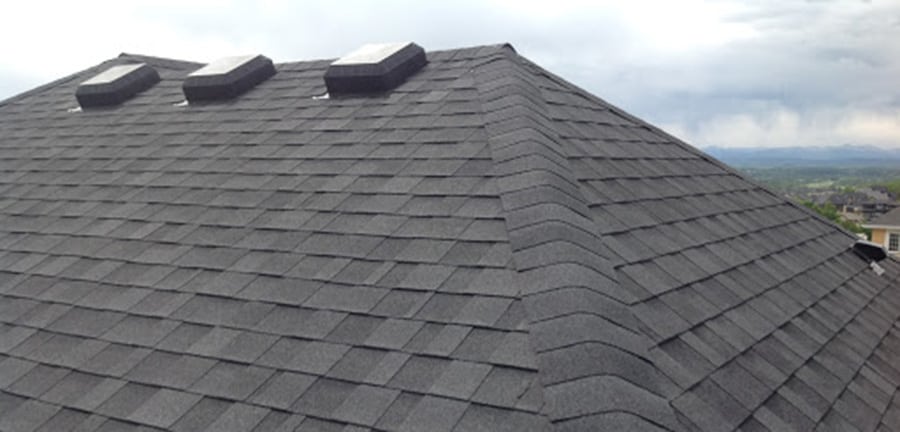
Roofs are made from several overlapping materials designed to keep the building safe from water damage and well-insulated and ventilated. According to NACHI, the most common materials used are asphalt, metal, wood, concrete, tile, and single-ply.
Each of these materials has advantages and disadvantages and will be susceptible to different types of damage. On top of this, not all materials offer the same level of structural strength as others, while some materials may pose a potential fire hazard. For example, asphalt shingles and wood shakes are far less fire-resistant than concrete and metal.
The inspector will identify the roofing material used, assess whether or not it is appropriate for the location and climate it must endure, and check to see visible signs of wear that are common for the material.
Roofing materials do have a limited lifespan. The following chart includes the estimated material lifespan. While this is a commonly accepted life expectancy, a replacement could be required much earlier. Typically, a total roof replacement would be recommended if a roofer has to replace 30% or more of the roof. Most roofers won’t repair a subpar roof.
| Roofing Material | Life Expectancy |
|---|---|
| Asphalt Roll Roof | 10 – 15 Years |
| Built-Up Roofing (BUR) | 20 – 30 Years |
| 3 Tab Asphalt Shingles | 15 – 20 Years |
| Architecture Shingles | 25 – 40 Years |
| Wood Shingles | 25 – 30 Years |
| Wood Shake Shingles | 35 – 40 Years |
| Corrugated Metal Roofing | 40 – 80 Years |
| Standing Seam Metal Roofing | 40 – 80 Years |
| Clay or Cement Tiles | 80 – 100 Years |
| Slate Tiles | 80 – 100 Years |
Despite the life expectancy listed, all roofs require routine maintenance. This maintenance is generally needed every 5 – 10 years and includes a thorough inspection and sealing around roof penetrations or flashing as required.
Gutters and Downspouts
According to NACHI’s Home Inspection Standards of Practice, home inspectors must inspect the gutters and downspouts during the general home inspection.
Problems with Downspouts
The SOPs recommend that downspout water divert at least four to six feet from the foundation. This is a reasonably common issue that can have profound implications. If the downspout is directing water straight towards the home’s foundations, it has the potential to cause severe structural damage.
A few inches of rain can produce thousands of gallons of water runoff. If the land surrounding the building has a negative gradient or the drainage is poor, this water has nowhere to go other than toward the basement, crawlspaces, and foundations.
Most gutter installers will install downspouts directly at the foundation. It’s up to the homeowner to install extension pipes, splash guards, or underground piping to direct the water away from the foundation. Most homeowners are unaware of this until after the installers have come and are long gone.
Left alone, downspouts discharging too close to the foundation can cause localized flooding, contributing to foundation problems after a few short years.
The downspout will also be inspected for a proper connection to the gutter and the roof structure and damage that weather conditions and vehicle impact can cause.
Downspouts should also avoid terminating onto other roof surfaces so they don’t cause secondary issues elsewhere. Discharging large quantities of stormwater runoff onto roof shingles will cause them to wear out faster and increase the likelihood of a roof leak forming.
Problems with Gutters
Home inspectors will examine the gutter system, looking for problems such as clogging, rust, cracks, holes, and leaks. Clogged rain gutters cause the water to overflow out of the gutter.
Sometimes, this water flows back underneath the shingles on the eaves, which can cause damage to the roofing materials and leaks in the attic.
A clogged gutter is usually caused by a buildup of fallen leaves, dirt, and silt, and it is easily removed. Homeowners should conduct roof drainage maintenance at least twice per year.
According to the Standards Of Practice, gutters should be adequately fitted and sloped towards the downspouts to prevent water runoff from being trapped in the gutters. If the gutters fail to prevent this runoff from exiting the gutters, water will collect inside the gutters, causing stress on the piping to pull away from the house under the added weight of the water.
Investing in gutter guard screenings is a good idea to prevent gutters from becoming clogged with debris. This reduces the need to clean gutters, which is safer since you won’t need to climb ladders or get onto the roof to clean them.
Quality of the Installation
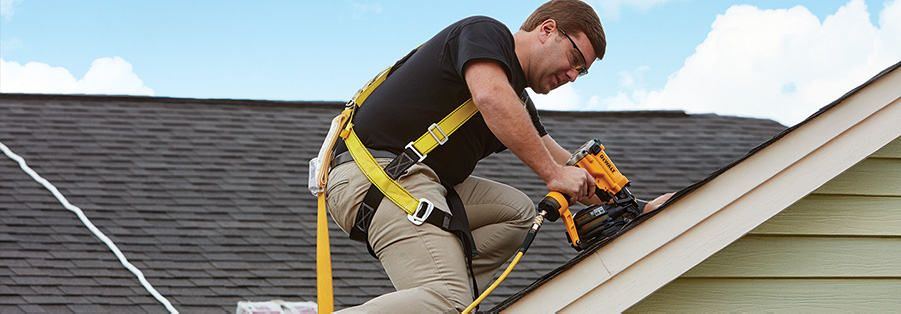
Many of the issues on our list can be attributed to low-quality roof installation. A general rule of thumb is that a well-installed roof made up of high-grade materials should last around 20-30 years. However, that is not always the case, mainly if a faulty installation occurs.
The inspector will check for poor-quality workmanship during the installation, including the shingles, flashings, vents, gutters, downspouts, and the overall roof structure. Incorrect shingle placement and poor flashing installments allow water to enter the building via the roof, causing damage.
The inspector may look for low-quality nail patterns, incorrect level of overhang, poor shingle positioning, the quality of roof underlayments, and the integrity of the roofing structure.
Most installation problems occur in valleys where shingles are improperly interlaced or flashed. Valleys are where two roof lines converge. Large amounts of water often flow toward the roof valleys; even minor flaws can cause major roof leaks over time.
Poor workmanship can also lead to wind damage. Wind can cause shingles that are not adequately fastened to become loose or break. If the shingles are wind-damaged, roof leaks can start around nail holes and seams.
Problems with Roof Shingles
Most residential roofs are covered with shingles. Even if installed perfectly, they still succumb to wear and tear and can become damaged over the years.
If the home has asphalt shingles or wooden shakes, watch out for any evidence of them curling at the edge. This indicates that the shingles are coming towards the end of their usable life and would need to be replaced.
The same can be said for evidence of buckling or blistering shingles. Large amounts of moss and lichen could point towards a decaying roof underneath and should be inspected further.
This is bad news if shingles are missing from the roof or appear to be broken. If you see this, alarm bells should be ringing in your head, as water may have penetrated the roof for some time.
It’s a good idea to professionally remove moss and other organic debris. Never let anyone pressure wash your roof. Pressure washing a roof will do more damage than good. A professional roof cleaner will spray a non-toxic, biodegradable cleaning solution on the roof and remove it with a soft wash similar to a light rain shower.
If some shingles start to curl or break, it’s safe to assume that others are also weak and could become wind-damaged at any time. Remember, a total replacement is the best option if 30% or more of the roof is damaged.
Problems with Chimneys
Home inspectors will perform a visual check of the chimney and will look to see if there are any large and apparent signs of obstruction. Various things can cause blockages, such as dead animals, bird nests, leaves, branches, etc. These blockages can become dangerous if left for too long as they allow toxic gasses, such as carbon monoxide, to build up in the home.
Chimneys accumulate creosote, a by-product that collects when you burn wood and other substances. When the smoke travels up the chimney, the creosote sticks to the sides and can cause blockages. Unfortunately, creosote is a flammable substance and must be removed regularly with routine chimney maintenance.
If a home inspector sees a buildup of creosote on the flue walls, a recommendation should be made to have the chimney flues cleaned and inspected by a chimney sweep.
Older homes will likely have brickwork and masonry issues, which could cause safety hazards. Neglected chimneys will crumble and eventually collapse if they aren’t given enough maintenance. Chimney joints can be repointed to ensure loose bricks and degraded masonry joints between bricks.
Masonry chimney caps are prone to cracking, leading to water intrusion that can damage the flue. Many older chimneys have open flues that allow rain to enter the chimney and potentially rust out the damper door. Most of these chimneys have missing rain caps and vermin screens.
Issues with the Roof Flashings
The roof flashing is one of the most critical aspects of the roof when it comes to keeping water out of the house. If the flashing is installed correctly and still functions, rainwater will be directed away from the roof’s vulnerable areas and into the drainage system.
If the flashings become damaged, the likelihood of a leak drastically increases. Home inspectors will pay close attention to problem areas of the roof, such as valleys, chimneys, skylights, and dormers. If the flashings are inadequate in any of these locations, the home inspector will note this in their report.
Step Flashing
For rooflines that build up against brick masonry walls, we commonly see problems with step flashing. Step flashing is the practice of interlocking pieces of metal flashing folded into the mortar joints in the brick masonry. The step flashing often doesn’t extend the wall high enough or overlap enough to shed water properly.
Kick-out Flashing
For rooflines that are up again siding, the flashing should have a piece of kick-out flashing along the wall. This kick-out flashing is used to shed water away from the siding. This flashing is often not present, particularly in older houses. Oddly, even in roof replacements on older homes, roofers fail to install it with the new installation.
Drip Edge Flashing
Drip edge flashing is another flashing used in roofing to protect the fascia boards. This flashing is laid over the transition between the fascia and roof and helps support the overlapping lip of the shingles.
The drip edge flashing also helps stormwater runoff flow into the gutters and not behind the gutters. The back wall of the gutter piping should fit directly under the lip of the drip edge flashing.
Encroaching Vegetation
To inspect the property’s exterior, the home inspector will assess nearby vegetation, such as plants and trees that encroach too close to the house.
Fallen trees and broken branches can cause significant damage to the roof of a property. In addition, leaves from the trees can clog up gutters, downspouts, and chimneys, causing a knock-on effect of several other issues. If leaves are left on the roof for too long, they can lead to mold and the deterioration of the shingles on the roof.
In addition to this, if there is a low-hanging branch near the house, there is a chance it could wear down the shingles or break the shingles, stripping off the important layers of asphalt and compromising the integrity of the roof structure.
According to both ASHI and NACHI standards of practice, it’s recommended that large trees and branches should be between eight and 10 feet away from the structure. This is to help protect the roof and prevent moisture damage to the foundations caused by the tree’s long-reaching roots.
Indications of Roof Leaks
As you can see from our list, the majority of roof issues that we have raised surround some form of water damage or leak. This is for a good reason, as water damage in the home can be devastating.
According to industry estimates, the annual cost of insurance companies from water damage is around $2.5 billion, and the average home water damage claim is roughly $7000. This is why home inspectors keep a keen watch for any indications of leaks throughout the property, especially on the roof. Here are some common signs that the roof may be leaking:
- Missing, cracked, or damaged shingles
- Water spots or water stains in the interior of the roof
- The presence of mold or mildew
- The pooling of water on the roof
- Inadequate flashings/improperly sealed valleys
- Ice dam buildup
- Condensation in the attic
Roof leaks often start slowly, which makes them hard to notice as the attic is one of the least frequented rooms in the whole house. If these leaks go undetected for quite some time, they can cause considerable damage throughout the property and leave you with a hefty repair bill later. Not something you want from your new house.
Lack of Overall Maintenance
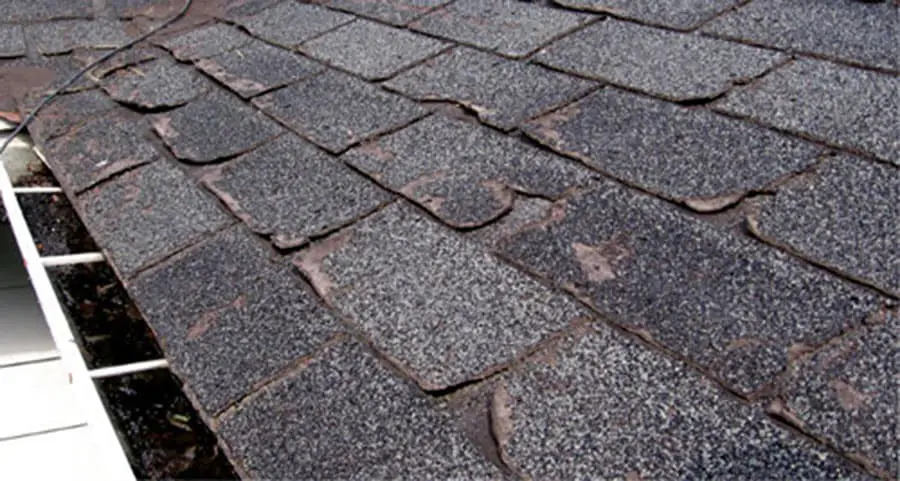
Even though the roof is a challenging area of the house to clean, regular maintenance must be conducted to ensure everything is in complete working order. As mentioned, the roof is the home’s first line of defense against the weather, and if one or more of the aspects of the roof have issues, it will likely result in some form of water penetration to the home.
Not only that, but taking good care of your roof goes a long way toward maintaining the value of your house, saving you thousands of dollars in repair bills, and making the sale process a whole lot easier when that time comes around. The home inspector will be on the lookout for any signs of poor quality maintenance on the roof, such as:
- Damaged gutters
- Loose flashing
- Missing and damaged shingles
- Tree branches, leaves, and other debris on the roof and in the gutter
- Rust
- Mold and mildew
- Neglected chimneys
- Ice dam formation
Signs of Pests & Other Animals
If there are problems with the roof, such as missing shingles or an open chimney flue, there’s a chance that the homeowner could be welcoming a whole bunch of unwanted guests into the attic. In general, the roof and attic space is a pest’s paradise. It’s dark and cool and offers plenty of food in the form of textiles and wood. Here’s a list of some of the most common pests that can be found in the roof and attic space and what that means for the home inspection:
Birds
Birds can nest in several places on your roof and even your chimney. While this may not seem like a problem initially, bird’s nests can cause clogs in gutters, downspouts, and chimneys. On top of this, most bird species have acidic droppings, which can damage key support structures and rot the shingles on the roof.
Vermin
Nobody wants to see vermin in a house they’re about to buy, but they are far more than just an unpleasant sight. Rats and mice burrow through your roof and can chew through insulation, pipes, and even your electrical system. This presents a risk of electrical fire and structural damage, even before we get to the diseases they carry!
Bees
Certain species of bees love to build their hives on roofs. If they can make their way through the shingles, they will start to develop their new bee colony, which can cause damage to the roof structure, especially if left unchecked. Carpenter bees will bore holes in wood facia to set up hives inside the eaves.
Termites and other wood-eating insects
Termites are the number one enemy of homes in the USA. They are known as the silent destroyers, quietly eating away at key support structures such as wooden joists and load-bearing walls. The roof and attic space are great places for termites to feed.
Termites will often feed through the floors, walls, and attics. While they live underground, they travel to and from through mud tubes. They can construct elaborate tunnels inside walls and may never be noticed unless you are trained and know what to look for.
What happens if a roof fails inspection?
If a roof fails inspection, it may present potential safety hazards and lead to leaks, water damage, and structural issues. Repairs or replacement may be necessary to bring the roof to code and ensure it is structurally sound and can protect the building and its occupants.
How long does a roof inspection take?
The duration of a roof inspection varies depending on the size and complexity of the roof. It typically takes around 1 hour for a thorough roof inspection.







